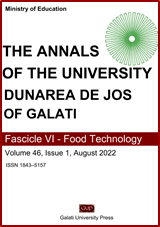Health promoting olive leaf as a food ingredient: industrial study on a confectionery product
Abstract
The chemical composition and functional properties of olive (Olea europaea L.) leaf powder (OL) as an ingredient to be used in green and sustainable food processing were determined. OL contained low moisture (8% of dry weight) and fat (1.6%), moderate rates of proteins (10.8%) and high amounts of carbohydrates (70.8 %) composed mainly of insoluble fibers (57.9%). Due to its high content in insoluble fibers, OL displayed high fat absorption power and moderate water solubility index and holding capacity. Therefore, OL can be an appropriate ingredient to stabilize lipid rich food formulations. OL was incorporated at an industrial scale in a pistachio paste based confectionery product. This addition enabled to protect the oil from oxidation during cooking, drying and storage of the pistachio paste mixture. Moreover, the microbiological quality, textural properties, sensory attributes, and overall acceptance of the product were improved. This work promotes the use of OL as a health promoting multi-functional food ingredient.


